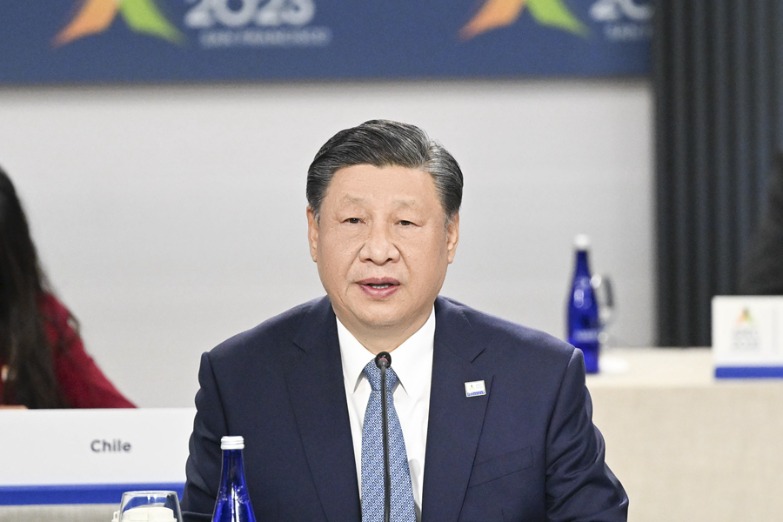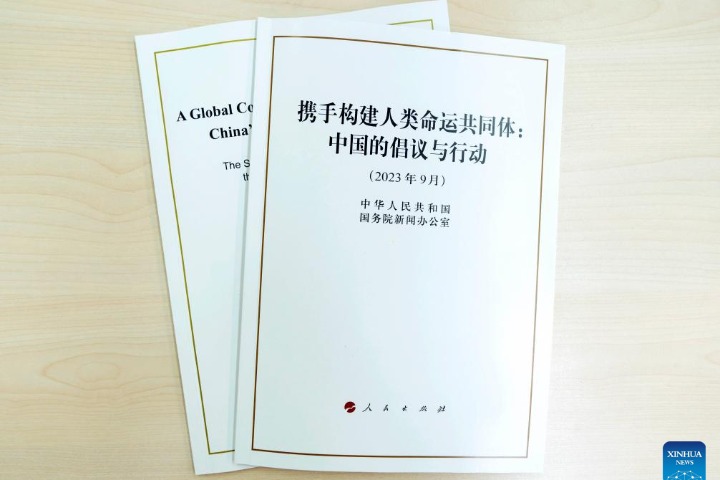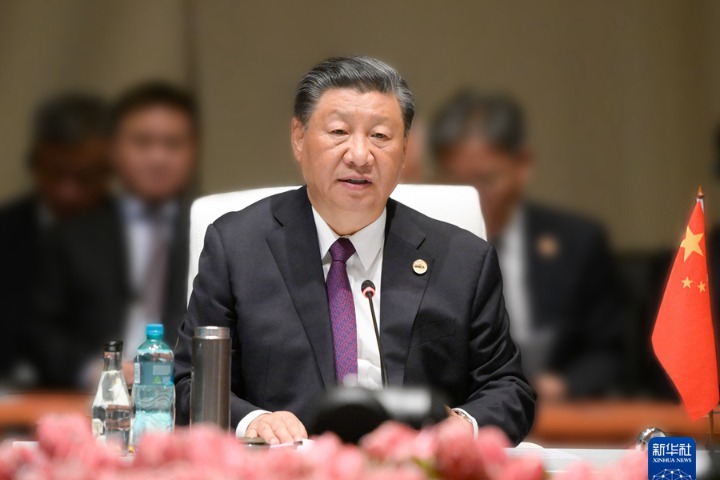2013政府工作报告全文(双语)
新华社 2013-03-19 09:22

五年来的主要工作及特点:
The following are the main work we accomplished over the past five years and its main features:
一是有效应对国际金融危机,促进经济平稳较快发展。过去五年,我们是在持续应对国际金融危机严重冲击中走过来的。这场危机来势之猛、扩散之快、影响之深,百年罕见。我们沉着应对,及时果断调整宏观调控着力点,出台进一步扩大内需、促进经济平稳较快增长的十项措施,全面实施一揽子计划。两年新增4万亿元投资,其中中央财政投资1.26万亿元,主要用于保障性安居工程、农村民生工程、基础设施、社会事业、生态环保、自主创新等方面建设和灾后恢复重建。五年来,新建各类保障性住房1800多万套,棚户区改造住房1200多万套;完成大中型和重点小型水库除险加固1.8万座,治理重点中小河流2.45万公里,新增节水灌溉面积770万公顷;新增铁路里程1.97万公里,其中高速铁路8951公里,京沪、京广、哈大等高铁和一批城际铁路相继投入运营;新增公路60.9万公里,其中高速公路4.2万公里,高速公路总里程达9.56万公里;新建机场31个;新增万吨级港口泊位602个;一批跨江跨海大桥、连岛工程相继建成;西气东输、西电东送、南水北调等重大工程顺利推进或建成;非化石能源快速发展,水电、风电装机位居世界第一;重建后的汶川、玉树、舟曲等灾区发生了翻天覆地的变化。这些举世瞩目的成就,对我们有效应对国际金融危机严重冲击发挥了至关重要的作用,为经济社会长远发展打下了坚实基础,已经并将继续造福亿万人民。
我们始终注重处理好保持经济平稳较快发展、调整经济结构和管理通胀预期的关系,增强宏观政策的前瞻性、科学性、有效性,注意把握好政策的取向、力度和重点。在国际金融危机冲击最严重时,果断实施积极的财政政策和适度宽松的货币政策,综合运用多种财政政策工具,增加政府支出,实行结构性减税;有效运用存款准备金率、利率等货币政策工具,保持货币信贷合理增长。根据宏观经济走势的变化,我们及时调整政策力度,适时退出刺激政策,实施积极的财政政策和稳健的货币政策。在财政政策运用上,坚持统筹兼顾,注重综合平衡。财政赤字占国内生产总值的比重从2009年的2.8%降到去年的1.5%左右,赤字率和债务负担率保持在安全水平。加强地方政府性债务全面审计和地方政府融资平台管理,有效控制经济运行中的风险隐患。在货币政策运用上,始终注意把握稳增长、控物价和防风险之间的平衡。金融体系运行稳健,银行业风险抵御能力持续增强,资本充足率从2007年底的8.4%提升到去年底的13.3%,不良贷款率由6.1%下降到0.95%。坚持搞好房地产市场调控不动摇,遏制了房价过快上涨势头。2012年,在世界各大经济体增长全面减速、各种风险不断暴露的情况下,我们合理把握政策力度,保持财政预算支出规模不变,优化支出结构,扭转经济下滑趋势,全面实现年初确定的主要目标,国内生产总值增长7.8%,城镇新增就业1266万人,居民消费价格涨幅回落到2.6%,为今年经济发展打下好的基础。
这五年,我国宏观经济总体上保持增速平稳较快、物价相对稳定、就业持续增加、国际收支趋于平衡的良好态势,国内生产总值年均增长9.3%,显著高于同期全球和新兴经济体的增速,通货膨胀率远低于其他新兴经济体。我国经济稳定,充满活力。
回首这五年,面对国际经济形势复杂多变、持续低迷的严峻挑战,中央科学判断、果断决策,有效避免了我国现代化进程因巨大的外部冲击而出现大的波折,实践证明这些决策部署是完全正确的。
In the past five years, we averted the grievous consequences of the global financial crisis, whose abruptness, rapid spread and profound impact were rarely seen in the past century. We responded to the crisis calmly, made timely and decisive adjustments to the focus of macro-control, adopted ten measures to increase domestic demand and promote steady and rapid economic growth, and implemented a comprehensive package plan. In a two-year period, an additional four trillion yuan of government investment was made, with 1.26 trillion yuan from the central government, mainly for building government-subsidized housing, improving rural people's wellbeing, building infrastructure, developing social programs, improving the environment, promoting innovation, and carrying out post-disaster recovery and reconstruction.
Over the past five years:
More than 18 million government-subsidized housing units of various types were built, and over 12 million housing units in run-down areas were upgraded.
A total of 18,000 large and medium-sized and key small reservoirs were reinforced, 24,500 kilometers of key small and medium-length rivers were harnessed, and water-saving irrigated farmland was increased by 7.7 million hectares.
A total of 19,700 kilometers of new rail lines were built, 8,951 kilometers of which are high-speed railways.
The high-speed Beijing-Shanghai, Beijing-Guangzhou and Harbin-Dalian railways and a number of intercity railways were opened to traffic.
A total of 609,000 kilometers of new roads were built, 42,000 kilometers of which are expressways, increasing the total length of expressways in service to 95,600 kilometers.
Thirty-one airports and 602 shipping berths for 10,000-ton ships were built.
A number of bridges over rivers and bays and linking islands with other islands and the mainland were completed.
Smooth progress was made in major projects such as those for transporting natural gas and electricity from the west to the east and diverting water from the south to the north, and some of the projects have been completed.
Non-fossil energy production developed rapidly, and China now ranks first in the world in the installed capacity of both hydropower and wind power.
Reconstruction of the Wenchuan, Yushu and Zhugqu disaster areas transformed them completely.
These impressive achievements played a vital role in our effective response to the severe impact of the global financial crisis, and laid a solid foundation for sustaining China's economic and social development. They have benefited and will continue to benefit hundreds of millions of people.
We always strove to maintain a balance between ensuring steady and rapid economic development, adjusting the economic structure, and managing inflation expectations. We made government macro policies more forward-looking, scientific and effective and implemented them with proper orientation, force and focus.
When the impact of the global financial crisis was at its worst, we resolutely implemented a proactive fiscal policy and a moderately easy monetary policy, employed a full range of financial policy tools, increased government spending and made structural tax reductions. We effectively employed monetary policy instruments such as adjusting required reserve ratios and interest rates to maintain proper growth in the money and credit supply.
In response to changing macroeconomic trends, we promptly adjusted the intensity of policy implementation, reduced the force of stimulus policies at an appropriate time, and implemented a proactive fiscal policy and a prudent monetary policy.
We took a holistic and balanced approach in employing fiscal policy. As a result, the government deficit dropped from 2.8% of GDP in 2009 to about 1.5% last year, and both deficit-to-GDP and debt-to-GDP ratios remained at a safe level. We strengthened comprehensive auditing of local governments' debt and management of their financing platforms, thus effectively controlling latent economic risks.
In employing monetary policy, we maintained a balance between ensuring steady growth, maintaining price stability and warding off risks. The financial system functioned soundly. The banking sector became better able to avert risks. Its capital adequacy rate increased from 8.4% at the end of 2007 to 13.3% by the end of last year, and its non-performing loans dropped from 6.1% to 0.95%.
We kept a firm grip on the real estate market and kept housing prices from rising too quickly.
In 2012, when other major economies in the world were experiencing a slowdown in growth and constantly encountered new risks, we maintained a proper intensity in policy implementation, kept budgetary spending unchanged, improved the spending mix, and reversed the decline in economic growth. As a result, we attained all the main targets set at the beginning of the year: GDP grew by 7.8%, 12.66 million urban jobs were created, and the rise in the CPI fell to 2.6%. All this laid a good foundation for China's economic development this year.
Over the past five years:
China's economy as a whole maintained steady and rapid growth.
Prices remained fairly stable.
Employment steadily increased.
The balance of payments moved toward equilibrium.
GDP grew at an average annual rate of 9.3%, considerably higher than the average global rate and the average rate of other emerging economies for the same period.
China's inflation rate was also much lower than that of other emerging economies.
The Chinese economy is stable and full of vitality.
In the last five years, faced with severe challenges posed by a complex and volatile international economic environment and a sluggish global economy, the central leadership, on the basis of a scientific judgment of the situation, made resolute decisions that steered China's modernization drive clear of major pitfalls created by huge external shocks. Experience fully proves these decisions and implementing steps were entirely correct.

















 英语点津微信
英语点津微信 双语小程序
双语小程序